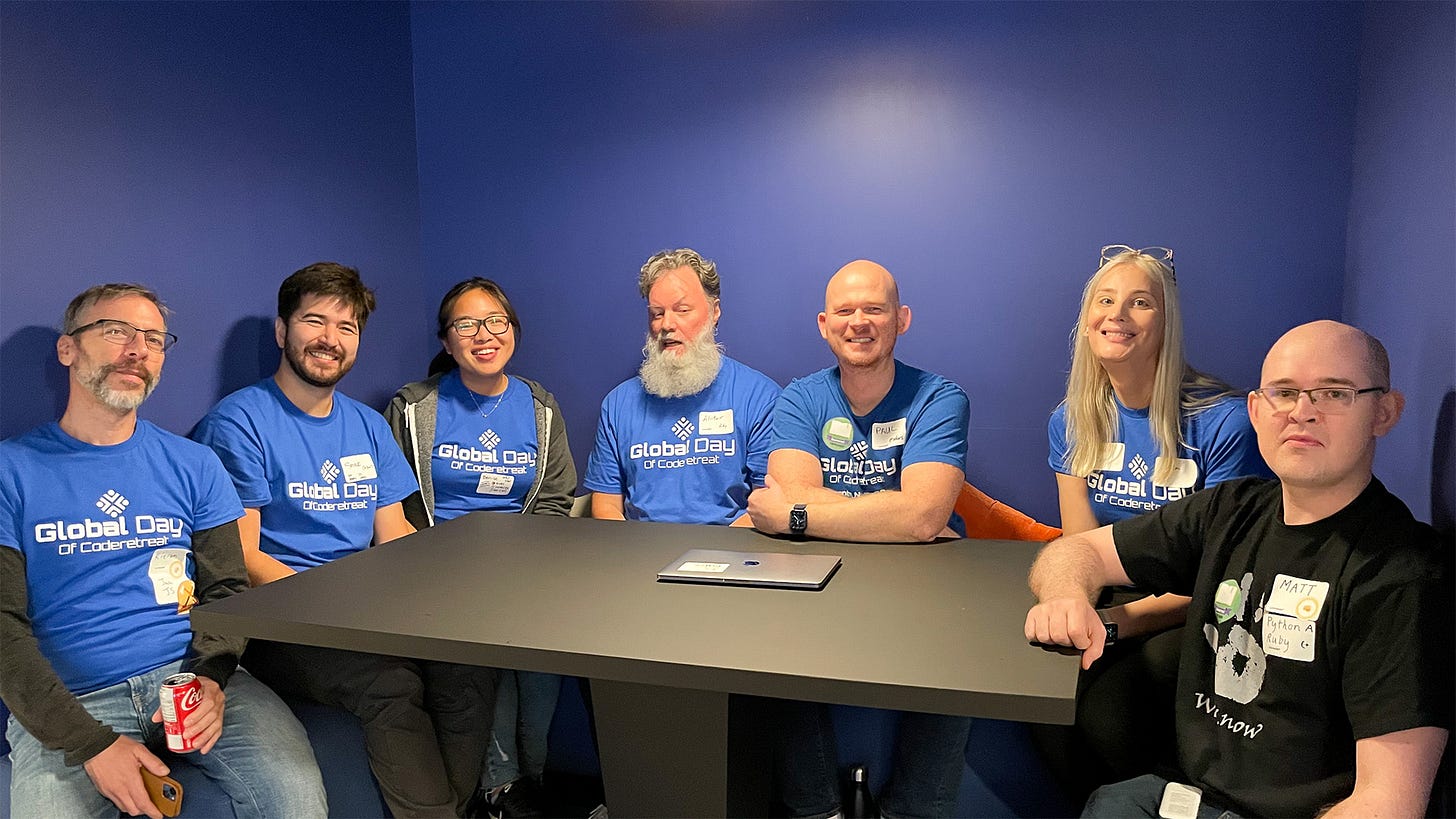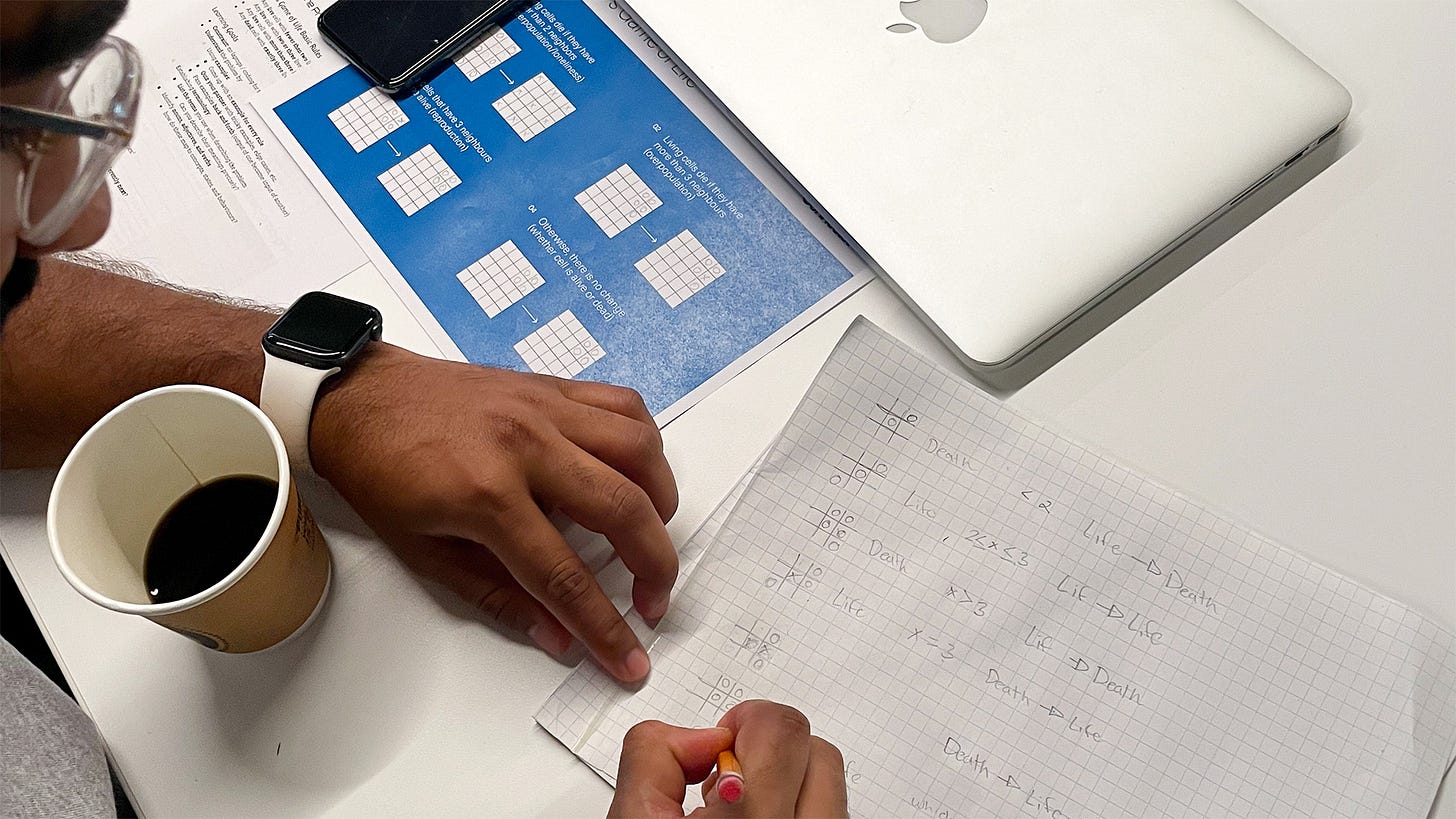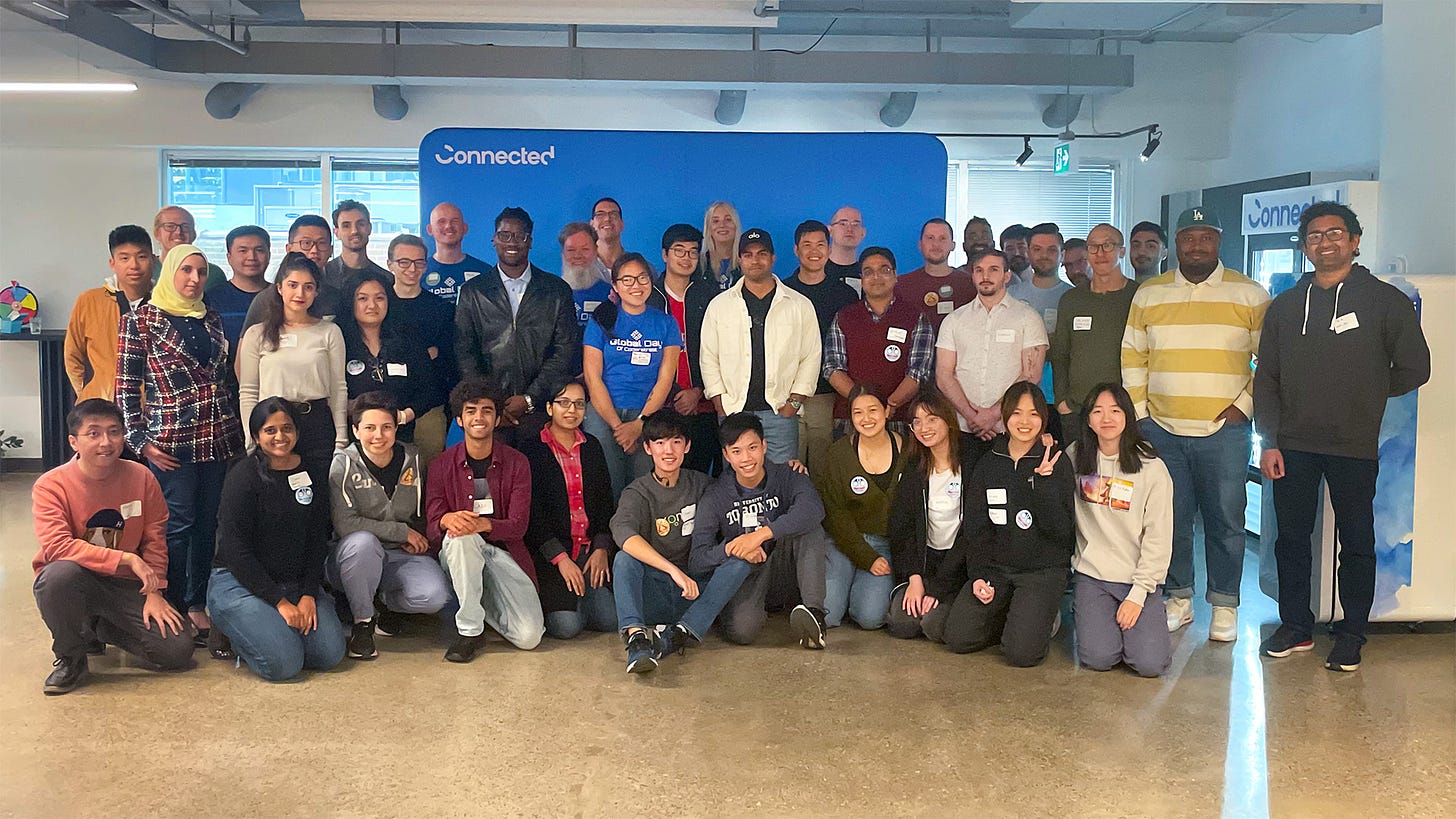Planning for Toronto's Global Day of Coderetreat 2022
How we scaled coderetreat to 40+ participants
This post was originally published on the Connected blog.
Earlier this month, we hosted Global Day of Coderetreat (GDCR) at our Toronto office. After a three-year hiatus from hosting, we wanted to re-awaken some of the community enthusiasm we witnessed when we hosted here for the first time in 2019. Consequently, we planned for a larger event this year. I’m thrilled to say that we nearly doubled our attendee count, going from 27 in 2019 to 45 this year.
In this article, I’ll cover how we scaled the workshop from one that typically involves under 20 participants to one that can handle three times that number. I hope that this will give you some ideas about hosting coderetreats in your tech communities, especially if you are concerned about the happy problem of a large turnout!
Partner with a passionate co-organizer
Four months out
Before you go down the path of planning Global Day of Coderetreat, I recommend partnering with someone who shares your enthusiasm for the event and its underlying purpose (to nurture software development skills in your community). This way, if you have weeks where you’re bogged down with competing responsibilities, you’ll have a partner to keep the event-planning momentum going.
It’s also important to establish a shared understanding with your co-organizer on how decisions on the event are reached. Will you both agree on everything together, will one of you get the final say, or will it depend on what you’re deciding on? Once you’ve established this with your co-organizer, the two of you will need to decide how you intend to leverage the broader set of event volunteers, including the facilitators who will be instrumental in the event’s success. For example, when planning this year’s event, my co-organizer and I consulted heavily with the facilitators on the workshop programming.

Delegate event planning unrelated to workshop programming to an independent volunteer team
Three-and-a-half months out
Having said that, it’s important that you make the best use of every volunteer’s time. For us, that meant only consulting with the facilitators on workshop programming, while non-specific event planning decisions, such as catering, were largely delegated to an independent volunteering team. Everyone was informed on what was being decided, however. This way, anyone could chime in on any proposal before it was committed to.
For example, coderetreat has a “no pizza rule.” This is something that may not be known by all volunteers, especially those new to organizing one, so it’s important that all key decisions are visible to both the facilitators and volunteers. In particular, this includes the dates when these decisions need to be “locked in” so everyone understands what can and can’t be changed.

Send out a call for facilitators
Three months out
As with any event, the success of coderetreat hinges on its attendees. Further, as a technical workshop, the quality of the experience is directly related to the number of qualified facilitators one can secure for the event. Therefore, the first action we took was to send out a “call for facilitators”. Even before creating a registration form for the event, we called on our personal, closed and public networks for people interested in facilitating it. These included:
Past colleagues that we worked with and facilitated past coderetreats
The online software crafters community, and
Social media (predominantly LinkedIn and Twitter)
Concretely, we asked people to fill out a form which collected the following information:
Interest in facilitating (or, failing that, interest in participating)
Preferred event dates (GDCR can be hosted on either a Friday or a Saturday, so we set a date that would allow for the highest number of facilitators to attend)
Preferred hosting method (in-person or virtual)
Past facilitator experience
Their email address for follow-ups
We followed up with everyone interested. While it’s theoretically impossible to have too many facilitators, we wanted to ensure they were sufficiently experienced in coderetreat. A common recommendation is to consider a facilitator sufficiently experienced if they have attended at least one coderetreat. Fortunately, we had a level of interest which allowed us to set this as the baseline.
Once we had a sense of how many facilitators we’d have for the workshop, we could decide the number of participants, as well as how to structure the workshop activities to best leverage the facilitators’ expertise.

Differentiate the event and target optimal participants
Two-and-a-half months out
We are still seeing the societal impact of the COVID-19 pandemic. In particular, in-person events in tech are far less popular and common than they used to be. Consequently, much of the interest, attention, and discussion online is around online events. In fact, it’s common for people to assume your event is online unless you explicitly specify that it’s happening in person.
This reduced demand for in-person events does come with a silver lining: there is a corresponding reduced supply. This means that it’s easier to differentiate your event from others, and getting the word out can be comparatively easier. In our case, we were the only in-person coderetreat in Canada that day, and there were only a couple of other tech events happening in Toronto that month.
Nonetheless, getting attendees for an in-person event on a weekend is no easy task. We thought about ideal personas to target for a day-long, hands-on coding workshop. Who would be willing, even eager, to give up their Saturday for such an event? After considering this, we targeted recent bootcamp grads and university students. Once we got in touch with the relevant individuals and had a chance to discuss it with them over a video call, they then reached out via their internal networks to promote the event for us. This strategy helped us boost in-person attendance by about 20%!

Intermittently remind both the registrants and the public about the event
Two months out
Here’s a truism worth stating: the most likely people to attend your event are those who have already registered for it!
Therefore we reached out periodically to our registrants via email, suggesting that they tell their friends and sharing reading material with them to get them familiar with and excited about the event. As a bonus, this reminded them about the event, which prevented them from making conflicting plans accidentally.
We were also very lucky to have highly supportive event organizers at our company who shared the event internally and encouraged everyone at the company to promote the event on social media. By far, LinkedIn helped drive most of our attendees, so this was a critical piece of our promotion strategy.
Begin planning the workshop programming
One month out
We began planning the workshop programming only one month out from the event. We were tempted to begin planning this earlier. Waiting, however, meant that we had a much clearer idea of the number of attendees to expect. This allowed us to plan session activities that worked well for the anticipated size of the event. It also meant that the programming stayed fresh in the facilitators’ minds as they were looped in on it only a few weeks before the event itself.
There is ample precedent around how to organize a day-long in-person coderetreat. A default structure as well as common activities, can all be found on coderetreat.org’s Facilitation Guide. If you’ve never organized a coderetreat before, there is plenty of support via that resource, as well as the complementary Software Crafters Slack community.

Conduct an on-location dry-run of the event
One week out
A dry-run or dress rehearsal of the event is absolutely critical. Try as we might, there is no way to visualize everything that can go wrong ahead of time. And in truth, a dry-run doesn’t guarantee this either. It does drastically reduce the number of things that can go wrong, however.
In our case, we conducted a dry-run the day before the event. We could do so as we were already quite familiar with the event space (it being our office, after all). Some aspects that came up included seating position relative to the projector screen, slide size, and anticipating how traffic will flow over the course of the day. It also gave the facilitators a chance to gain a much more concrete feel of what to expect on the event day.

Wrap-up
Hope this write-up helps you plan for your next coderetreat. In regards to deciding what to plan, at which point, use the principle of the last responsible moment to ensure you are maximizing your options while making the best use of everyone’s time. At the same time, remember to plan early and to not turn down help while also channelling that help appropriately. Pair up with a co-organizer and limit decision-making to the two of you while consulting with the wider group of volunteers. If needed, make it explicit that while you can’t promise to agree on everything, you can promise to hear everyone out.
In a follow-up post, we will share more about the event itself: what went well, what we learned, and what we’d like to experiment with at the next coderetreat we organize. Stay tuned!



